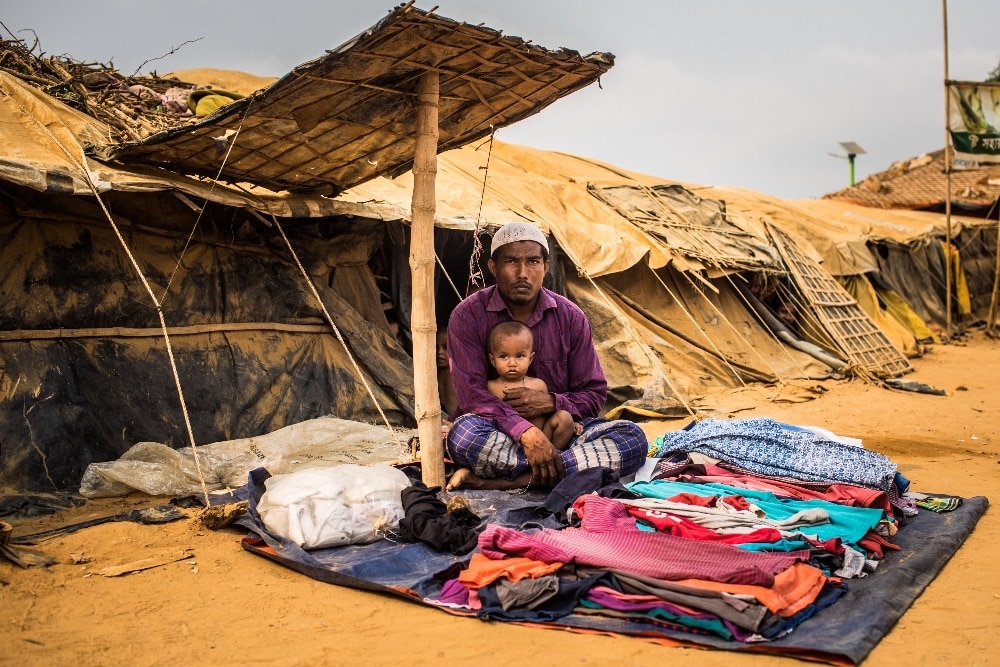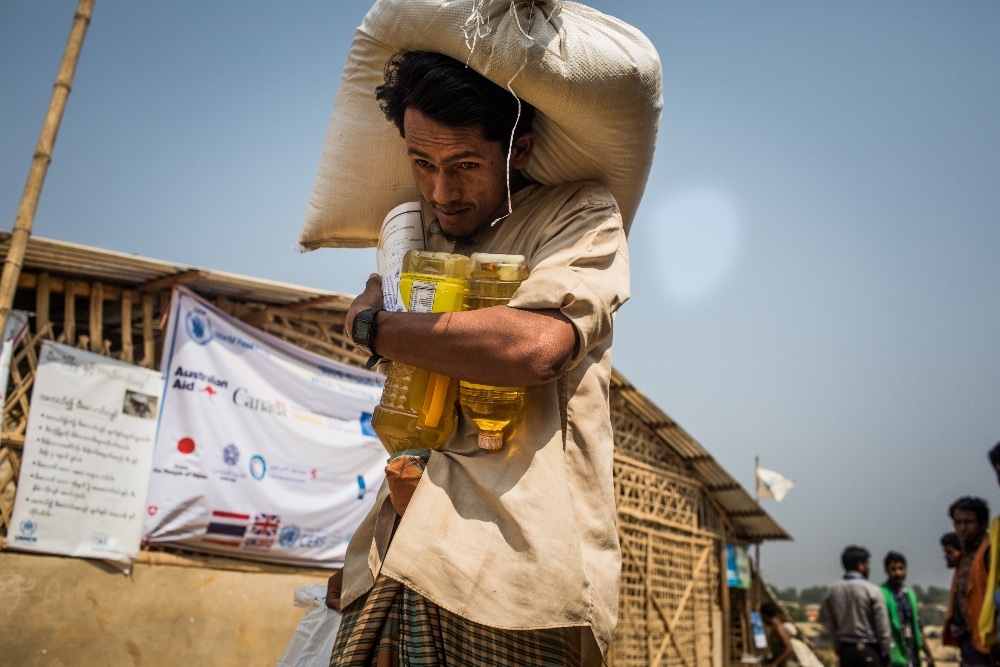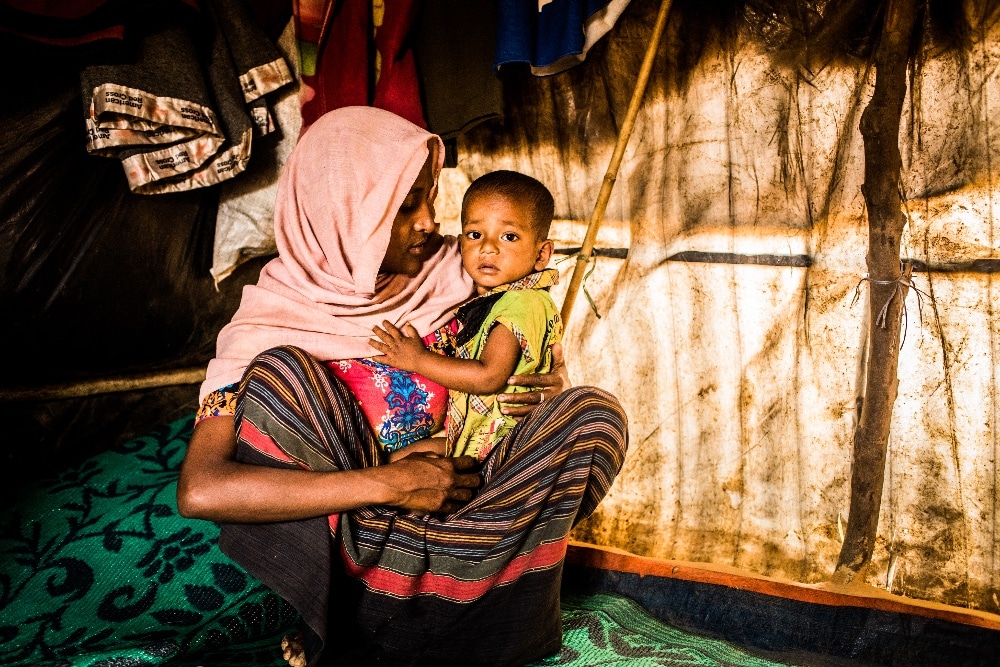Over one million Rohingya, a Muslim minority from Myanmar, have fled conflict and persecution in multiple waves of displacement. The most significant exodus occurred in August 2017 when 742,000 ethnic Rohingya fled military persecution in Myanmar for neighbouring Bangladesh. Those fleeing violence and attacks joined around 300,000 individuals who had previously sought refuge in Bangladesh. Currently, the region is home to 1.1 million Rohingya refugees who rely entirely on humanitarian assistance for protection, food, water, shelter and health. Thousands more refugees have fled to neighbouring countries, and over 2.8 million people are internally displaced within Myanmar, 90% since the military takeover.
Who are the Rohingya?
The Rohingya, a Muslim ethnic minority, have lived for centuries in Myanmar, mostly in Rakhine state, the poorest region of predominantly Buddhist Myanmar, formerly known as Burma. Despite their historical presence, the Rohingya lack official recognition as an ethnic community. Many Rohingya have no legal identity or citizenship, with statelessness a significant issue. Since 1982, they have been denied citizenship, leading to them becoming the world’s largest stateless population. This lack of official recognition leaves Rohingya families without basic rights and protection, making them susceptible to exploitation, sexual and gender-based violence (SGBV), and various forms of abuse. A majority of stateless Rohingya refugees (98%) currently reside in Bangladesh and Malaysia.

What is the crisis About?
The Rohingya have endured decades of persecution and discrimination in Myanmar, prompting over 1 million Rohingya refugees to flee violence in successive waves of displacement since the 1990s. The most significant exodus began in August 2017 after widespread violence erupted in Myanmar’s Rakhine State, driving more than 742,000 individuals, mainly women and children, to seek refuge in Bangladesh. During this period, there were widespread reports of human rights violations: entire villages burned to the ground, numerous families suffered fatalities or separations, and many embarked on dangerous sea voyages across the Bay of Bengal in search of safety in Bangladesh. Currently, about one million Rohingya refugees live in Cox’s Bazar, in Bangladesh, one of the world’s most densely populated camp areas.
Cox’s Bazar – the largest refugee settlement in the world
The majority of Rohingya refugees reside across 33 camps in Cox’s Bazar, forming the largest refugee settlement globally. The overcrowded conditions in the camps are incredibly challenging for women and children who face high risks of violence, exploitation, and human trafficking. Ensuring a secure habitat for refugees remains a persistent challenge, especially regarding safeguarding against natural disasters such as floods and landslides during the monsoon season from June to October. Moreover, during this period, inadequate water and sanitation facilities heighten the risk of waterborne diseases like hepatitis, acute diarrhoea, and dengue among the refugee population.
Humanitarian challenges in Myanmar
Over three years after the military takeover in February 2021, Myanmar faces a dire humanitarian crisis, affecting one-third of its population – approximately 18.6 million people – who urgently require humanitarian assistance. This staggering figure represents nearly nineteen times the pre-military takeover estimates, underscoring the severity of the situation. The military coup and subsequent violent repression have exacerbated the suffering of minority communities, including the Rohingya Muslims, plunging the nation into deep social, political, and economic turmoil.
Since October 2023, clashes between the military and armed opposition factions have escalated and spread throughout Myanmar, intensifying the human rights emergency. The military’s actions, including the targeting of civilians and forced recruitment campaigns, have led to widespread displacement, with over 2.8 million people now displaced nationwide. In Rakhine State, the escalation of violence between the Myanmar military and the Arakan Army, a separatist group, has reached an unprecedented intensity, aggravating existing vulnerabilities.

Economic pressures are mounting, exacerbating food insecurity for an estimated 12.9 million individuals in 2024. The situation is deteriorating even further as disruptions to agriculture persist and poverty continues to escalate. The healthcare system is in a crisis, leaving millions without secure shelter or access to clean drinking water. Women, girls, persons with disabilities and stateless Rohingya people are among those impacted the most.
Moreover, the breakdown in the rule of law in Myanmar has allowed illicit economies to thrive. The country has become a hub for methamphetamine and opium production, as well as the rapid growth of global cyberscam operations, especially in border regions.
According to the UN High Commissioner for Human Rights, overall, for 2023, the number of civilians reportedly killed by the military rose to over 1,600, an increase of some 300 from the previous year. As of 26 January 2024, credible sources had documented the arrest of nearly 26,000 people on political grounds. More than 4,600 individuals have been killed by the military since February 2021, including hundreds of women and children.
A large number of Rohingya continue to flee to safer countries, often taking immense risks, including dangerous sea crossings. In 2023, out of the 6,500 individuals travelling by land and sea, nearly all the 569 persons reported as dead or missing resulted from maritime crossings.
In May 2023, Cyclone Mocha hit Bangladesh and Myanmar — one of the strongest cyclones ever to hit the region. Cyclone Mocha impacted more than 10 million people in both countries, including the Rohingya refugees in Bangladesh.
How is the crisis affecting children?
Children bear the brunt of the crisis, with 6 million experiencing challenges related to displacement, interrupted healthcare and education, food insecurity, malnutrition, and protection risks like forced recruitment and mental distress. Rohingya children in Rakhine State face confinement due to violence, forced displacement, and limitations on freedom of movement.

Until conditions in Myanmar permit Rohingya families to return home with essential rights – safety from violence, citizenship, free movement, health, and education – they remain as refugees or internally displaced persons, residing in overcrowded and sometimes hazardous conditions.
UN Response to the crisis: UN Agencies involved and their role
Myanmar is fast becoming a forgotten crisis. The UN’s 2023 Myanmar Humanitarian Needs and Response Plan received only about 1/3 of its required funding. Humanitarians will need almost a billion dollars to reach 5.3 million people prioritized for urgent assistance.
The 2024 Joint Response Plan for the Rohingya Humanitarian Crisis aims to help some 1 million Rohingya refugees in Cox’s Bazar and on the island of Bhasan Char and 346,000 from host communities with food, shelter, health care, access to drinkable water, protection services, education and livelihood opportunities and skills development.
Six UN agencies including the UN Migration Agency (IOM), the UN Refugee Agency (UNHCR), the UN Population Fund (UNFPA), the UN Children’s Fund (UNICEF), the UN Women and the World Food Programme (WFP) implement Rohingya refugee response projects at refugee camps in Cox’Bazar and Bhasan Char following the allocation of over USD 9 million from the United Nation’s Central Emergency Response Fund (CERF) in January 2023. They provide life-saving services to the Rohingya refugees staying in camps in Cox’s Bazar district and on the island of Bhasan Char and over 17,800 members of the host community in Ukhiya and Teknaf.
To learn more about how the UN Agencies help the Rohingya, go to the respective pages:
UNICEF – UNHCR – WFP – UNFPA – IOM – UN WOMEN
Special Rapporteur on the situation of human rights in Myanmar, Tom Andrews, issued several statements urging coordinated international action that supports the heroic efforts of the people of Myanmar.
